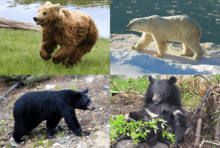Ursus (genus) facts for kids
Quick facts for kids Ursus |
|
|---|---|
 |
|
| From top to bottom: Brown bear, American Black Bear, Polar bear, Asian Black Bear. | |
| Scientific classification | |
| Kingdom: | |
| Phylum: | |
| Class: | |
| Order: | |
| Family: | |
| Genus: |
Ursus
Linnaeus, 1758
|
| Species | |
|
|
Ursus is a group, or genus, of large mammals known as bears. This group includes some of the most famous bears, like the brown bear, the polar bear, and the American Black Bear. The word Ursus comes from the Latin word for "bear." These animals are part of the Ursidae family, which is the scientific name for all bears.
Contents
All About Ursus Bears
Bears in the Ursus genus are known for their strong bodies, thick fur, and powerful claws. They are generally large animals, though their size can vary a lot between different species. Most Ursus bears have a good sense of smell and hearing. They use these senses to find food and stay safe.
What Makes a Bear a Bear?
Bears are mammals, which means they are warm-blooded and their mothers feed milk to their babies. They walk on all four legs, and most can stand up on their hind legs. Their paws are large, and they have five strong claws on each foot. These claws are great for digging, climbing, and catching food. Bears also have short tails and excellent eyesight, especially at night.
Where Do Ursus Bears Live?
Bears in the Ursus genus live in many different parts of the world. They can be found in forests, mountains, tundras, and even near the Arctic Ocean. Each species has adapted to its specific environment. For example, polar bears live in icy, cold regions, while brown bears live in forests and mountains across North America, Europe, and Asia.
What Do They Eat?
Most Ursus bears are omnivores, meaning they eat both plants and animals. Their diet can include berries, nuts, roots, insects, fish, and small mammals. Some bears, like the polar bear, are mostly carnivores, eating seals and other marine animals. Other bears, like the American black bear, eat more plants and insects. Their diet often changes with the seasons, depending on what food is available.
Life Cycle and Behavior
Bears usually live alone, except when mothers are raising their cubs. Female bears give birth to one to four cubs, often in a den during winter. The cubs are born very small and helpless. They stay with their mother for about two to three years, learning how to find food and survive.
Many Ursus bears, especially those in colder climates, go into a deep sleep called hibernation during winter. During this time, their body temperature drops, and their heart rate slows down. They live off the fat they stored during the warmer months.
Different Kinds of Ursus Bears
There are several living species within the Ursus genus, each with unique features:
Brown Bear (Ursus arctos)
The brown bear is one of the most widespread bear species. They live in parts of North America, Europe, and Asia. Brown bears can be many different shades of brown. They are known for the hump of muscle on their shoulders, which gives them great digging power. They eat a wide variety of foods, from berries and roots to fish and large animals.
American Black Bear (Ursus americanus)
The American black bear is the smallest and most common bear in North America. Despite their name, they can be black, brown, or even cinnamon-colored. They are excellent climbers and often use trees for safety or to find food. Their diet is mostly plants, fruits, nuts, and insects.
Polar Bear (Ursus maritimus)
Polar bears live in the Arctic regions around the North Pole. They are the largest land carnivores and are perfectly adapted to their icy home. They have thick fur and a layer of blubber to keep warm. Polar bears are strong swimmers and primarily hunt seals. Their white fur helps them blend in with the snow and ice.
Asian Black Bear (Ursus thibetanus)
The Asian black bear is found in forests across Asia. They are also called moon bears because of the white crescent shape on their chest. They are good climbers and spend a lot of time in trees. Their diet includes fruits, nuts, insects, and small animals.
Protecting Ursus Bears
Many Ursus bear species face challenges today. Habitat loss, climate change, and human activities threaten their populations. For example, polar bears are losing their sea ice habitat due to global warming. Conservation efforts are very important to protect these amazing animals and ensure they can thrive in the future. This includes protecting their habitats and reducing conflicts between bears and humans.
See also
 In Spanish: Ursus para niños
In Spanish: Ursus para niños

